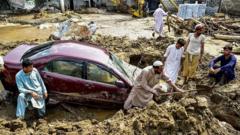More than 200 people are still unaccounted for in Buner district of north-west Pakistan following catastrophic monsoon flooding and landslides. An official from the area reported that at least 209 inhabitants have been reported missing, with the possibility of that number rising as rescue teams continue their search. Over the past few days, flash floods have resulted in over 300 fatalities across Pakistan and Pakistan-administered Kashmir, predominantly in the mountainous Khyber Pakhtunkhwa region.
Jehangir Khan, a spokesman for the deputy commissioner office in Buner, indicated that rescue teams have been compelled to bury eight unidentified bodies due to the absence of family members present to claim them. The destruction of roadways has hindered many relatives from reaching the sites where their loved ones may be located.
Asfandyar Khattak, the head of the provincial disaster management authority, indicated that "dozens" remain missing in the nearby Shangla district, while reports suggest that whole villages have been partially buried under debris.
The annual monsoon rains, which occur between June and September, typically account for about 75% of South Asia's yearly precipitation. However, climate change is believed to be intensifying these weather-related disasters. Recent torrential rains have also affected regions of Indian-administered Kashmir, where at least 60 people died in similar flooding incidents earlier this week.
In addition, authorities in Pakistan-administered Kashmir reported nine fatalities, while five people died in the northern Gilgit-Baltistan region. The Pakistan Meteorological Department has issued forecasts of heavy rainfall expected until August 21 in the north-western territories, with multiple areas already declared disaster zones.
This year's monsoon season has wreaked havoc across Pakistan, leading to at least 650 deaths to date. In July alone, Punjab, which is home to nearly half of Pakistan's 255 million inhabitants, recorded 73% more rainfall than the previous year, contributing to higher death tolls than those observed in the last monsoon season.
Northern Pakistan is particularly vulnerable due to its status as one of the most glaciated regions in the area. However, climate change is causing these glaciers to retreat, resulting in the loosening of rocks, soil, and debris that can trigger landslides. Though the precise causes of the recent floods and landslides are still under investigation, scientists point to melting ice as a significant contributing factor.





















